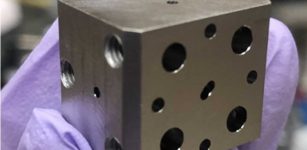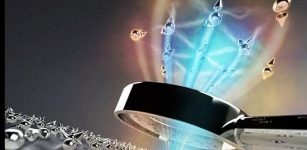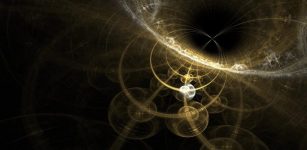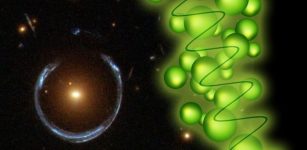A “Quantum-Inspired” Revolution In Microelectronics
Eddie Gonzales Jr. – MessageToEagle.com – In a laptop, binary ones and zeroes are represented by transistors at low or high voltage. On a compact disc, a “one” occurs where an indented “pit” turns to flat “land,” while a zero indicates no change. Historically, the size of these objects has limited storage device size.
A crystal used in the study charges under UV light. The process created by Zhong Lab could be used with a variety of materials, taking advantage of rare earths’ powerful, flexible optical properties. (Image courtesy of Zhong Lab)
But now, University of Chicago Pritzker School of Molecular Engineering (UChicago PME) researchers have explored a technique to make ones and zeroes out of crystal defects, each the size of an individual atom, for classical computer memory applications.
The innovation showcases UChicago PME’s interdisciplinary research, using quantum techniques to revolutionize classical computers and transform radiation dosimeters into groundbreaking microelectronic memory storage.
“Each memory cell is a single missing atom – a single defec,” said UChicago PME Asst. Prof. Tian Zhong. “Now you can pack terabytes of bits within a small cube of material that’s only a millimeter in size.”
“We integrated solid-state physics applied to radiation dosimetry with a quantum research group,” said first author Leonardo França, a postdoctoral researcher in Zhong’s lab. “While our work isn’t exactly quantum, there’s demand for both quantum system research and improved storage capacity of classical non-volatile memories. Our work is based at this interface between quantum and optical data storage.”
França’s research began during his PhD at the University of São Paulo, Brazil. He studied radiation dosimeters, which record the radiation exposure of workers in hospitals and other facilities.
“In the hospitals and in particle accelerators, for instance, it’s needed to monitor how much of a radiation dose people are exposed to,” said França. “There are some materials that have this ability to absorb radiation and store that information for a certain amount of time.”
He soon became fascinated about how through optical techniques – shining a light – he could manipulate and “read” that information.
“When the crystal absorbs sufficient energy, it releases electrons and holes. And these charges are captured by the defects,” França said. “We can read that information. You can release the electrons, and we can read the information by optical means.”
França soon saw the potential for memory storage. He brought this non-quantum work into Zhong’s quantum laboratory to create an interdisciplinary innovation using quantum techniques to build classical memories.
“We’re creating a new type of microelectronic device, a quantum-inspired technology,” Zhong said.
Rare earth
To create the new memory storage technique, the team added ions of “rare earth,” a group of elements also known as lanthanides, to a crystal.
Specifically, they used a rare-earth element called Praseodymium and an Yttrium oxide crystal, but the process they reported could be used with a variety of materials, taking advantage of rare earths’ powerful, flexible optical properties.
“It’s well known that rare earths present specific electronic transitions that allows you to choose specific laser excitation wavelengths for optical control, from UV up to near-infrared regimes,” França said.
Unlike with dosimeters, which are typically activated by X-rays or gamma rays, here the storage device is activated by a simple ultraviolet laser. The laser stimulates the lanthanides, which in turn release electrons. The electrons are trapped by some of the oxide crystal’s defects, for instance the individual gaps in the structure where a single oxygen atom should be, but isn’t.
“It’s impossible to find crystals – in nature or artificial crystals – that don’t have defects,” França said. “So what we are doing is we are taking advantage of these defects.”
While crystal defects are often used in quantum research to create “qubits,” the UChicago PME team found another use. They controlled when defects were charged or not, designating a charged gap as “one” and an uncharged gap as “zero.” This transformed the crystal into a powerful memory storage device beyond classical computing capabilities.
“Within that millimeter cube, we demonstrated there are about at least a billion of these memories – classical memories, traditional memories – based on atoms,” Zhong said.
Written by Eddie Gonzales Jr. – MessageToEagle.com Staff Writer











